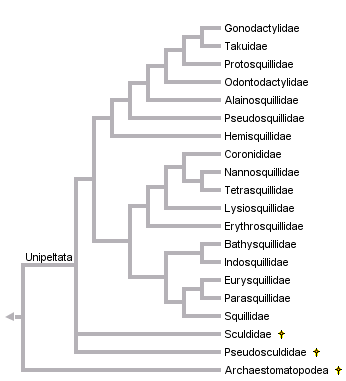Mantis Shrimp: A Deceptive Foe
Biology 342 Fall 2012
Will Horner, Jules Weinstein
Phylogeny
Evolutionary Tree of Stomatopods
Stomatopods are crustaceans in the sub group of maricosta, which is shared by other shrimp. A close relative is the snapping shrimp, which uses a similar arm mechanism. However, stomatopods belong in their own namesake order.

Picture from http://tolweb.org/Stomatopoda/6299. Yellow crosses indicate that those species are extinct. All living Stomatopods are in the suborder Unipeltata (12).
Since all have the raptorial appendage and exhibit this behavior, it is probable that both evolved far back  along the evolutionary tree (4). At right is an image of Tyrannophontes acanthocercus, a stomatopod species not belonging to Unipeltata that lived during the Carboniferous period (roughly 350-300 million years ago) (4). Note the similarity in body structure and the pre-raptorial appendage.
along the evolutionary tree (4). At right is an image of Tyrannophontes acanthocercus, a stomatopod species not belonging to Unipeltata that lived during the Carboniferous period (roughly 350-300 million years ago) (4). Note the similarity in body structure and the pre-raptorial appendage.
Picture from http://dpc.uba.uva.nl.
Over time, stomatopods have evolved a very ritualized fighting system primarily consisting of threat displays and aggressive movement without actual conflict. This has served to increase the life expectancy over generations and is a beneficial trait (5).
 Stomatopods form an evolutionarily stable system with the use of ritualized fighting and threat displays in order to circumvent the costs of a violent conflict. In a simple model based on the strength of the stomatopods in a violent conflict, the stronger will always win but will still suffer costs due to the conflict (10).
Stomatopods form an evolutionarily stable system with the use of ritualized fighting and threat displays in order to circumvent the costs of a violent conflict. In a simple model based on the strength of the stomatopods in a violent conflict, the stronger will always win but will still suffer costs due to the conflict (10).
Picture from http://arsanatomica.tumblr.com.
However, adding threat displays complicates the situation. It may reach the point where threats replace violence, in which stronger and larger stomatopods will threaten more confidently and win (10). However, a large molting stomatopod may hijack this system and threat confidently and frequently, keeping its territory and defeating its opposition. In this situation, evolutionary time will tend towards stomatopods who threat frequently when molting to have an advantage (1).
Even in the event of a threat being ineffective, there is little damage done as the defenseless molter can flee swiftly. The stomatopod can therefore avoid the cost of the conflict. The result is a stable system in which threat-happy stomatopods are outweighed by those able to call their bluffs, though this is risky against a larger specimen (1).
In the end, molting stomatopods are able to survive adequately over time, allowing the propagation of the species, and therefore the repeating of this threat pattern in future generations of stomatopods.